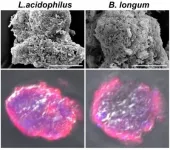(Press-News.org) A University of Arizona Health Sciences study has estimated total lifetime costs at $736 million for the 10,359 valley fever patients diagnosed in Arizona in 2019, underscoring the economic burden the disease places on the state and its residents.
The prevalence of valley fever, formally known as coccidioidomycosis or cocci, has increased in recent years, from 5,624 cases diagnosed in Arizona in 2014 to 10,359 cases in 2019. There currently are no certain means of prevention or vaccination for the fungal disease, which is caused by spores of Coccidioides, a family of fungi found in soils of the Southwest.
The findings highlight the need for a vaccine, better therapeutic options and more consistent use of rapid diagnostic testing - all areas of focus at the UArizona College of Medicine - Tucson's Valley Fever Center for Excellence. The study, "Clinical and Economic Burden of Valley Fever in Arizona: An Incidence-Based Cost-of-Illness Analysis," was recently published in the journal Open Forum Infectious Diseases.
"I was overwhelmed by how important this disease is in Arizona and how preventable some of the costs may be," said lead author Amy Grizzle, PharmD, associate director of the Center for Health Outcomes & PharmacoEconomic Research (or HOPE Center) in the UArizona College of Pharmacy. "Because it's kind of an isolated disease, I didn't necessarily think it was that expensive. I'm gratified that this study was able to shed some light on how many people this disease affects and how costly it is, especially taking into consideration some of the long-term complications."
Dr. Grizzle said she was surprised by the $736 million total, which can be broken down into direct and indirect costs of $671 million and $65 million, respectively. Among direct costs, she said, are health expenses expected over a person's lifetime, including hospitalization, diagnosis and treatment (chest X-rays, rapid diagnostic tests, medications, surgery, etc.), and follow-up care including skilled nursing facilities for rehabilitation. Indirect costs include short-term work loss and lost earnings due to premature mortality.
The study examined the cost-of-illness for valley fever's five primary manifestations:
Primary uncomplicated pneumonia, which comprises 85% of diagnosed valley fever cases;
Chronic pneumonia, which often requires treatment for two to three years;
Disseminated infection, which requires lifelong medication, periodic testing, and recurring hospitalization, and is the leading cause of death among valley fever patients;
Other pulmonary changes - pulmonary nodules, which account for about 7% of all valley fever cases; and,
Other pulmonary changes - pulmonary cavities, which affect about 3% of all valley fever patients. Patients with pulmonary changes, whether nodules or cavities, often require expensive diagnostics to rule out lung cancer, and about 40% of such cases require hospitalization.
Researchers found that severe cases of valley fever where the disease spreads to other parts of the body, known as disseminated valley fever, resulted in the highest economic burden at nearly $1.4 million per person.
The study's estimated lifetime costs are comparable to a 2019 California study that put total lifetime costs for the 7,466 people diagnosed with Valley fever in the Golden State in 2017 at just under $700 million, according to co-author John Galgiani, MD, an infectious diseases specialist with the College of Medicine - Tucson who also is director of the UArizona Valley Fever Center for Excellence and a member of the BIO5 Institute.
Leslie Wilson, PhD, of the University of California San Francisco, led the California study and is a co-author on the Arizona study along with Drs. Grizzle and Galgiani, and David Nix, PharmD, of the UArizona College of Pharmacy.
Dr. Galgiani, who founded the Valley Fever Center in 1996, said two-thirds of all valley fever cases reported in the U.S. occur in Arizona, with half in Maricopa County. Only about 5% of U.S. valley fever cases are reported outside of Arizona and California.
The primary symptoms of valley fever are respiratory problems similar to bacterial pneumonia, though more serious complications can arise when the infection spreads beyond the lungs to other areas including bones, joints, and the brain and central nervous system.
Delays in diagnosis are common because valley fever symptoms can mimic those of the flu or bacterial pneumonia. Such confusion often means ineffective treatment with antibiotics, instead of antifungals like fluconazole, for days or weeks, during which time a patient's condition might deteriorate. The situation has worsened with the emergence of COVID-19, Dr. Galgiani said.
"Basically, doctors were under-diagnosing valley fever in the springtime, because of several reasons. One, people were being tested for COVID and, when they were negative, they didn't do any more testing," Dr. Galgiani said. "And two, people weren't seeking hospital care for anything if they didn't think it was COVID."
Drs. Galgiani and Grizzle say the economic impacts highlighted in the study underscore the value of supporting research into developing more rapid diagnostic tests, better therapies and ultimately a preventative vaccine to address this important public health problem in Arizona.
"Hopefully, after more treatments and/or a vaccine are available, we can do another cost of illness analysis 10 years from now and see that these medications have greatly reduced the economic burden to Arizona," Dr. Grizzle said.
INFORMATION:
Feb. 10, 2021 - A new paper published online in the Annals of the American Thoracic Society describes a "virtual" recovery program for sepsis patients that may also help post-COVID-19 patients and survivors of other serious illnesses.
In " END ...
Scientists from Nanjing University and the University of Macau have devised a new approach to extend the survival of transplanted probiotics in vivo, enhancing the efficacy of cancer chemo-/immunotherapies in mice. The paper entitled "Smectite promotes probiotic biofilm formation in the gut for cancer immunotherapy" appears online today in Cell Reports.
The gut contains trillions of symbiotic bacteria. Disturbing the balance of intestinal flora may increase the occurrence of major diseases, including cancers. The gut microbiome plays an essential role in regulating the host immunity, which has inspired strategies to modulate intestinal microorganisms ...
Nagoya University scientists have developed a chemical reaction that produces high yields of a compound used in a wide variety of industries, without needing high temperatures or toxic catalysts. The approach was described in the journal ACS Catalysis and offers a practical and sustainable solution for industrial (meth)acrylate (= acrylate or methacrylate) ester synthesis.
(Meth)acrylate esters are used in industrial coatings and masonry, and to make plastics, dyes and adhesives. But the chemical process for making them from methyl (meth)acrylates ...
As families settle back into a new school year, sleep experts at the University of South Australia are reminding parents about the importance of teenagers getting enough sleep, cautioning them that insufficient sleep can negatively affect their mental health.
In a new research paper, UniSA sleep experts Dr Alex Agostini and Dr Stephanie Centofanti confirm that sleep is intrinsically linked to mental health, but is commonly overlooked by health practitioners as a contributing factor.
Dr Agostini says it's imperative that parents and medical practitioners ...
For all their importance as a breakthrough treatment, the cancer immunotherapies known as checkpoint inhibitors still only benefit a small minority of patients, perhaps 15 percent across different types of cancer. Moreover, doctors cannot accurately predict which of their patients will respond.
A new study finds that inherited genetic variation plays a role in who is likely to benefit from checkpoint inhibitors, which release the immune system's brakes so it can attack cancer. The study also points to potential new targets that could help even more patients unleash their immune system's natural power to fight ...
DALLAS, Feb. 10, 2021 — Reducing the prevalence of obesity may prevent up to half of new Type 2 diabetes cases in the United States, according to new research published today in the Journal of the American Heart Association, an open access journal of the American Heart Association. Obesity is a major contributor to diabetes, and the new study suggests more tailored efforts are needed to reduce the incidence of obesity-related diabetes.
Type 2 diabetes is the most common form of diabetes, affecting more than 31 million Americans, according to the U.S. Centers ...
Researchers at Uppsala University and the Swedish University of Agricultural Sciences have used new methods for DNA sequencing and annotation to build a new, and more complete, dog reference genome. This tool will serve as the foundation for a new era of research, helping scientists to better understand the link between DNA and disease, in dogs and in their human friends. The research is presented in the journal Communications Biology.
The dog has been aiding our understanding of the human genome since both genomes were released in the early 2000s. At that time, a comparison of both genomes, and two others, revealed that the human genome contained circa 20,000 genes, down ...
Increased level of plasma cells linked to improved cancer survival
1,300 prostate tumor samples studied
Immunotherapy-based precision medicine clinical trials being developed
CHICAGO--- Black men die more often of prostate cancer yet, paradoxically, have greater survival benefits from immunotherapy treatment. A new Northwestern Medicine study discovered the reason appears to be an increase of a surprising type of immune cell in the tumor. The findings could lead to immune-based precision medicine treatment for men of all races with localized aggressive and advanced prostate cancer.
In the new study, Northwestern scientists showed tumors from Black men and men ...
CHAMPAIGN, Ill. -- When modified using a process known as epoxidation, two naturally occurring lipids are converted into potent agents that target multiple cannabinoid receptors in neurons, interrupting pathways that promote pain and inflammation, researchers report. These modified compounds, called epo-NA5HT and epo-NADA, have much more powerful effects than the molecules from which they are derived, which also regulate pain and inflammation.
Reported in the journal Nature Communications, the study opens a new avenue of research in the effort to find alternatives to potentially addictive opioid pain killers, researchers say.
The ...
Tokyo, Japan - Researchers from Institute of Industrial Science at The University of Tokyo investigated the mechanism of phase separation into the two phases with very different particle mobilities using computer simulations. They found that slow dynamics of complex connected networks control the rate of demixing, which can assist in the design of new functional porous materials, like lithium-ion batteries.
According to the old adage, oil and water don't mix. If you try to do it anyway, you will see the fascinating process of phase separation, in which the two immiscible liquids spontaneously "demix." In this case, the minority phase always forms droplets. Contrary to this, the researchers ...





